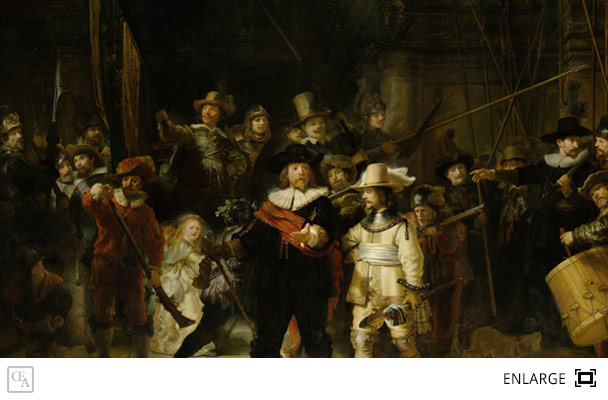
It is a military portrait painted in 1642 and was commissioned by Captain Banning Cocq for the purposes of being hung in the Musketeers' Meeting Hall, which had recently been built in Amsterdam, or also possibly to celebrate the visit of exiled French queen Marie de Medici.
The painting depicts a number of members of a militia, many of them holding muskets, standing in a darkened street in what appears to be the middle of the night. In the midst of them, bathed in a white light, is a strange, enigmatic figure dressed in white robes, giving off an angelic or celestial impression.
History of the Painting
Militia Company of District II under the Command of Captain Frans Banninck Cocq (The Night Watch) is one of the best-known paintings of The Dutch Golden Age, and continues to serve as a defining work of the era.
While at first it was hung in the Musketeers' Meeting Hall, it was eventually moved to the Town Hall in Amsterdam in 1715, and then to the Trippenhuis during Napoleon's occupation. It was moved to the Rijksmuseum in 1885, once the museum had been built.
During World War II, in order to protect the painting from damage, it was removed from its frame, and stretched around a wooden cylinder, then stored in a castle just North of Amsterdam. It survived the war, and was placed back on its frame and returned to the museum from where it had been taken.
It was over half a century later, in 2003, when it was once again moved during a renovation at the Rijksmuseum, only to be returned ten years later, once the renovations were finished. It remains here currently, undisturbed for the past several years.
The Night Watch has been subjected to vandalism a few times in its existence, most notably two people have slashed the painting with knives—once in 1911, and once in 1975—both times resulting in damage to the piece. The second attacker later died by his own hand in a mental institution less than a year later, his institutionalization unrelated to the vandalism, for which he was never charged. Attempts to restore the painting from this vandalism was largely successful, though on close inspection small imperfections are still somewhat apparent.
The painting was the victim of an acid attack in 1990, though luckily the acid was quickly diluted with water, so the damage was very minimal and only affected the top varnish layer of the work.
Influence
This highly-recognizable work has inspired many imitations and parodies over the centuries, and even three-dimensional, sculptural re-imaginings of it. The painting was also the subject of the 1995 American TV film that shares its title, a fictional work starring Pierce Brosnan and Alexandra Paul about the theft of the painting in Amsterdam.
 Arts3 Network
Website edition
Arts3 Network
Website edition